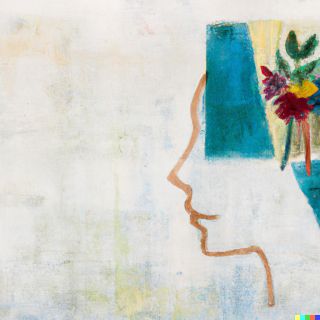Imagination
Rediscovering Wonder: How to Spark Adult Imagination
Imagination is a superpower that can boost creativity and transform us.
Posted August 30, 2024 Reviewed by Lybi Ma
Key points
- As children, our imaginations run free but as adults, our imagination can become idle and inflexible.
- A lack of imagination reduces problem-solving, social skills, resilience, job performance, and fulfillment.
- An enriched imagination permeates everything we know and perceive, allowing us to create novel possibilities.

Children see the world naively, with curiosity, wonder, and unfettered imaginations. When exploring the world, a child’s imagination is spontaneous, creative, and unconstrained by shored-up beliefs about reality and social norms. This creative and flexible imagination can be put to the side when in adulthood. As adults our cognitive processes, including creativity and imagination, become more structured and reality-bound, informed by what we have learned and lived experience (Weisberg and Gopnik, 2013). In other words, the quality of our creative thinking changes with developmental demands, becoming more practical, as it becomes more goal-directed, in the service of realistic problem-solving. Childhood reflects a period of exploration for reality and social construction. In adulthood, executive functioning takes center stage and imagination becomes more complex, incorporating abstract thinking, planning, decision-making, and mature empathy (Taylor and Carlson, 1997).
As stress and responsibilities increase, and the focus of imagination shifts to efficient problem-solving, one’s available mental space for creativity can become inflexible, or get squeezed out altogether. The imaginative play of childhood declines as adults’ engagement with playful activities decreases and we turn to routines, daily pressures, and career and family responsibilities (Pellegrini and Smith, 1998). But, a lack of imagination can produce significant negative outcomes in multiple areas including problem-solving, emotional resilience, social skills development, job performance, and personal fulfillment (King and Hicks, 2014). When your imagination becomes rigid or underutilized, you may struggle to find novel solutions to new situations, envision and plan for future scenarios, and or experience social difficulties due to a lessened ability to understand other people’s points of view or empathy. To fully flourish as adults, we must be intentional about nurturing and expanding our imaginative capacities, working with changing demands across the lifespan.
What Is Imagination and What Are the Benefits?
Imagination is a complex cognitive process involving the ability to create mental images, ideas, and constructs that are not physically present, including symbols and other representations of things (Currie and Ichino, 2013). A robust imagination improves cognitive flexibility, creative thinking, and problem-solving; as well as, bettering our ability to connect and bond with others, manage stress, decrease anxiety, and process difficult emotions (Drapeau, 2018).
Curiosity is closely linked to imagination. It is a desire to acquire new knowledge and experiences. Curiosity stimulates and enhances imaginative thinking as it encourages the exploration of new possibilities and solutions (Silvia and Kimbrel, 2010). Curiosity and imagination often overlap. Both revolve around novelty. Further, they exhibit a reciprocal relationship, driving and reinforcing one another. Both fuel creativity where one’s imaginative ideas are transformed into something interesting, valuable, and novel.
How Do I Improve My Imagination?
Some people are more creative by nature, so there is a genetic link that influences imagination and creativity; however, these traits are strongly influenced by environmental factors and individual life experiences. Even if you are not naturally a highly creative individual, your imagination, as an adult, can be nurtured by implementing several specific practices.
When you intentionally participate in creative activities, you are stimulating your imagination. The particular activity you choose is up to you, it’s about finding something that engages you so you’ll return to it over and over again. Activities like writing, drawing, painting, or playing music are familiar ways to enhance imagination but even coloring, doodling, and viewing art have been shown to enhance imaginative thinking, improve mood and increase emotional wellness (King and Hicks, 2014).
There are other ways to stimulate your imagination (Drapeau, 2018). Spending time in nature enhances imaginative thinking, by providing exposure to a rich array of sensory experiences such as diverse shapes, textures, and sounds, as well as movement, open spaces, and natural materials. When we become more connected to the natural world around us, it opens us up and generates positive emotions like joy and calm that increase focus and spark creativity. Other activities also nurture imagination. Mindfulness and meditation reduce stress and foster a more positive and expansive imagination. Engagement in positive social interactions releases a cascade of dopamine, serotonin, and oxytocin, creating an optimal environment for creative imagining.
Perhaps the most critical practice for improving your imagination is becoming more open to new experiences. Openness to experience and exposure to novel situations is very strongly correlated with increased creativity, curiosity, personal growth, aesthetic appreciation, absorption and flow, divergent ideation, innovative problem-solving strategies, and willingness to entertain a variety of perspectives (Abu and colleagues, 2023). When you are open to novel experiences, people, and places you are more likely to gain new knowledge and consider alternative points of view so your creative imagination is optimally positioned to spark and recognize new, original ideas.
A practice related to openness is intellectual risk-taking. Here we are not discussing behavioral recklessness but the kind of risk you experience when you share a unique idea or new solution with other people. Especially when these ideas differ from convention, you are taking a risk. When you put a novel idea out to others, you risk failing or being perceived in a negative light. Risk, opportunity, innovation, and failure all overlap with one another. Even in failure, you are learning and growing. Giving in to a fear of failure and rejection restricts idea generation and creative, imaginative thinking. Challenging your conventional thought patterns and employing exploratory thinking are critical tools for expanding your imagination and creativity. We live in a time of terrific uncertainty. Learning to embrace uncertainty and take intellectual risks will open new opportunities, improve the flexibility of your imagination, and enhance your creativity.
Let the Mind Wander
A final practice that can help boost your imagination is allowing time for daydreaming. Daydreaming is seen by many people as a waste of time but structured imaginative activities promote creative thinking. Positive imagination can lead to creative problem-solving and emotional processing (Smallwood and Schooler, 2015). When we use our minds to simulate imagined worlds and situations, we briefly set aside the mundane and routine aspects of our daily lives and, in doing so, invite inspiration. Permitting yourself to daydream; and, creating time and space to engage in the practice can improve the flexibility of your imagination and foster creativity.
A note for those with children, by fostering your child’s imagination, you are also boosting your own. When you read books or tell stories together, create art, spend time in nature, and or encourage role play and pretending, you are equipping your kids with greater potential for academic achievement, professional innovation, and personal fulfillment—but you are also, enhancing your imagination.
Imagination is pivotal to understanding the world and to propelling us beyond what we know to create new ideas, and innovations and build personal growth. When we imagine new ways of living and can imagine the world through the imagination of others, we can begin to create better ways of living. When individuals and groups can identify and pursue alternative futures, our ability to collectively respond to sustainability challenges increases and can inform policy and decision-making on a global scale, able to enhance social, ecological, economic, and cultural well-being in our uncertain world (Moore and Milkoreit, 2020).
References
Abu Raya M., Ogunyemi A.O., Rojas Carstensen V., Broder J., Illanes-Manrique M., Rankin K.P. (2023). The reciprocal relationship between openness and creativity: from neurobiology to multicultural environments. Frontiers in Neurology, 14. doi: 10.3389/fneur.2023.1235348.
Drapeau, S. (2018). Imagery and emotional regulation: A review. Frontiers in Psychology, 9, 2406. DOI: 10.3389/fpsyg.2018.02406
Currie, G. & Ichino, A. (2013). Imagination and make-believe from: The Routledge Companion to Aesthetics, Routledge. https://www.routledgehandbooks.com/doi/10.4324/9780203813034.ch31
King, L. A., & Hicks, J. A. (2014). Imagination and the Pursuit of Meaning: The Role of Future-Oriented Thinking in Personal Fulfillment. Journal of Personality and Social Psychology, 107,4, 614-627.
Moore, M-L. & Milkoreit, M. (2020). Imagination and transformations to sustainable and just futures. Elem Sci Anth, 8, 1. DOI: https:// doi.org/10.1525/elementa.2020.081
Pellegrini, A. D. & Smith, P. K. (1998). The Development of Play during Childhood: A Review of the Literature. Child Development, 69, 3, 1004-1021.
Silvia, P. J., & Kimbrel, N. A. (2010). The relationship between openness to experience and creativity: A meta-analysis. Personality and Social Psychology Review, 14,3, 316-332.
Smallwood, J., & Schooler, J. W. (2015). The science of mind-wandering: Empirically navigating the stream of consciousness. Annual Review of Psychology, 66, 487-518. DOI: 10.1146/annurev-psych-010814-015331
Taylor, M. & Carlson, S. M. (1997). The Relation Between Individual Differences in Fantasy and Theory of Mind. Child Development, 68(3), 436-455. doi:10.1111/j.1467-8624.1997.tb01953.x
Weisberg, D. S. & Gopnik, A. (2013). Pretense, Counterfactuals, and Bayesian Causal Models: Why What Is Not Real Really Matters. Cognitive Science, 37, 8, 1360-1381. doi:10.1111/cogs.12069




